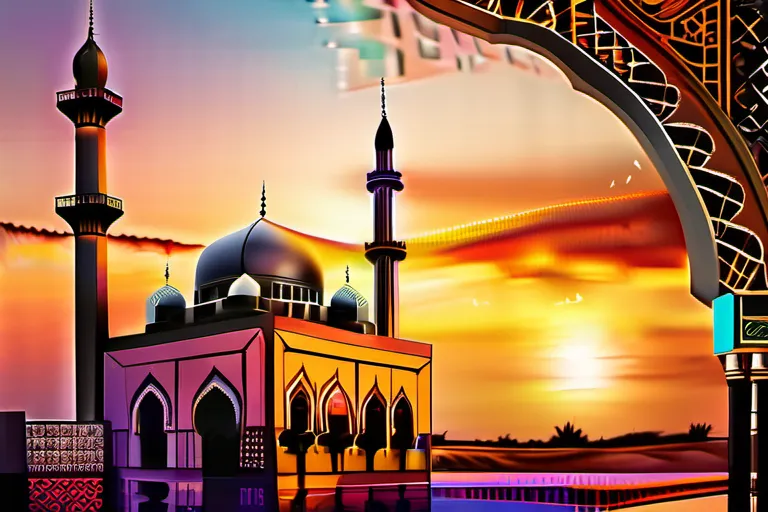Explore the history, architecture, and significance of mosques as religious, cultural, and social centers in Islam.
Mosques are essential buildings in Islamic communities, serving as places of worship, learning, and community gathering. In this article, we delve into the rich history, architectural significance, and unique features of mosques across the globe.
The Significance of Mosques in Islam
Imagine stepping into a mosque, like entering a portal to a world steeped in history and spirituality. What strikes you first are the towering minarets, reaching up towards the sky as if stretching hands towards Almighty Allah. These structures symbolize not just height but also the aspirations of the faithful who climb them, seeking closeness with their Creator.
Mosques have been more than mere places of worship; they are living centers that pulsate with life. They serve as a heartbeat for the Muslim community, providing a sanctuary where people from all walks of life can gather. These buildings are not just edifices of stone and mortar but also gateways to culture and knowledge. Think about it: have you ever seen a mosque that doesn’t contain an educational institution or a library within its premises? It’s almost as if the Prophet Muhammad (PBUH) himself said, “Seek knowledge even if in China,” inscribed above these sanctuaries of learning.
The significance of mosques extends far beyond religious rituals. They are community hubs where social issues are discussed, and solutions are sought. Imagine a mosque during Ramadan; it becomes the epicenter of nightly Iftar feasts, where strangers become neighbors through shared meals and prayers. These spaces foster unity and understanding, transcending barriers of race, nationality, or social status.
Mosques also play a crucial role in preserving cultural heritage. Their architectural designs often reflect the local artistry and craftsmanship of their regions. For instance, the intricate calligraphy adorning the walls of mosques might tell stories from the Quran or Hadiths, making sacred texts accessible to all worshippers through visual arts. This blend of functionality and beauty creates a unique atmosphere where faith and culture intertwine harmoniously.
So, when you step into a mosque, remember that you are partaking in an ancient tradition that continues to evolve while honoring its rich history. Each mosque is a testament to the enduring spirit of Islam and the profound impact it has on shaping communities around the world.
Islamic Architecture: Key Features and Elements
What immediately strikes you when you step into a mosque? The towering minarets that seem to pierce through the sky, the expansive domes that reflect sunlight like a thousand shimmering mirrors, and the intricate arches that support the weight of history itself. These architectural features are not just decorative; they serve vital functions and embody deep symbolism in Islamic culture.
The minaret, for instance, is more than just an aesthetic addition. It serves as a call to prayer, echoing across the city with the Adhan (call to prayer) that gathers Muslims from near and far. Imagine those ancient stones vibrating in response to the voices of centuries past, their echoes carrying on a timeless tradition.
The domes, often the most visible feature, symbolize the heavens above. They represent a connection between earth and sky, a bridge built by man but guided by divine will. Think about how these domes, like the capstone of a cathedral, unite believers under one spiritual roof, emphasizing unity in diversity.
The courtyards, with their lush greenery and tranquil spaces, offer a stark contrast to the bustling world outside. They are more than just open spaces; they provide a sacred retreat where worshippers can reflect, pray, and seek solace. Picture yourself standing under a tree in this courtyard, feeling the weight of history on your shoulders as you meditate on the beauty around you.
Together, these elements create an environment that is both functional and spiritual. They ensure that mosques remain centers not only for prayer but also for community gatherings, educational sessions, and social services. The architecture of a mosque is a testament to its role in fostering unity, learning, and compassion within the Islamic faith.
As you explore these structures, ask yourself: How do they inspire you? What messages do they convey about the values of Islam? And how can their beauty and symbolism inform your understanding of this rich and diverse religion?
The Evolution of Mosque Design
Imagine tracing the journey of mosque design, from its humble beginnings to the breathtaking architectural wonders we see today. The evolution of mosque architecture is like following a map through time, guiding us through the rich tapestry of Islamic history and culture.
The earliest mosques, such as the Masjid al-Nabawi in Medina and Masjid al-Haram in Mecca, were simple yet profound spaces. They started as modest buildings serving both religious and social purposes, with no grandiose features that we see today. These early mosques were more like intimate gathering places where the community could come together to pray and discuss matters of faith.
As Islam spread across the globe, so did its architectural styles. The Al-Aqsa Mosque in Jerusalem is a great example, showcasing the intricate mosaic work and elaborate decorations that would become hallmarks of mosque architecture during the Umayyad period. Each layer of decoration tells a story, from the geometric patterns symbolizing infinity to the calligraphy adorning walls with verses from the Quran.
The Alhambra in Granada, Spain, and the Taj Mahal Mosque in Lahore, Pakistan, are like jewels set on the crown of Islamic architecture. These grand structures not only served as places of worship but also became symbols of wealth, power, and cultural prosperity. The domes reaching towards the sky, the minarets that echo across distances with their melodic calls to prayer – every element is carefully crafted to evoke a sense of awe and reverence.
Today, mosques continue to evolve, blending traditional Islamic architecture with modern design elements. From eco-friendly buildings in Qatar to futuristic designs in Dubai, these mosques serve as not just places of worship but also as centers for education, social interaction, and community development. They stand as testaments to the adaptability and resilience of a faith that has endured for centuries.
Mosques as Cultural and Social Centers
Imagine walking into a mosque, stepping from the bustling outside world into a sanctuary where time seems to slow down. Mosques are more than just places of worship; they are vibrant centers that serve as the heart and soul of communities. How do these spaces become so integral to people’s daily lives? Let’s explore how mosques act as cultural and social hubs, fostering a sense of belonging and unity.
Picture a mosque during the early morning hours. People from all walks of life gather, breaking down barriers of age, gender, and socioeconomic status. Here, everyone is equal in their devotion to Allah, creating an environment where differences are not just acknowledged but celebrated. Is it any wonder why mosques have become such powerful institutions for cultural exchange?
Mosques often host a myriad of activities that extend beyond prayer times. From classes on Islamic teachings and history to workshops on calligraphy and traditional crafts, these spaces serve as educational centers where knowledge is shared freely. Could it be said that mosques are like libraries of the heart, where stories and traditions are preserved?
The social aspect of mosques cannot be overstated. Whether it’s a community meal (iftar) during Ramadan or a fundraiser for those in need, these events bring people together to support one another. These gatherings are not just about giving; they are about receiving the warmth and kindness that often feels like family. How do you define home when so many find solace and comfort within the walls of their local mosque?
Mosques also play a crucial role in providing support during times of crisis. From organizing medical aid to offering psychological counseling, these centers are always ready to assist those who need it most. Are mosques just places of worship, or do they embody the spirit of community service and compassion?
In essence, mosques serve as multifaceted spaces that enrich not only spiritual lives but also communal bonds. They offer a platform for learning, socializing, and cultural exchange, making them indispensable to the fabric of Muslim communities worldwide. Can you imagine life without these vibrant centers of activity and unity?
The Role of Mosques in the Lives of Muslims
Imagine stepping into a mosque for the first time; it’s like entering a sanctuary where every inch tells a story. What exactly is a mosque, you might wonder? It’s more than just a place of worship—it’s the heart of the Muslim community, a multifaceted center that echoes with the daily rituals and practices of its faithful.
At the core of it all are the daily prayers. Imagine the rhythmic sound of the call to prayer echoing through the streets, drawing people from their homes. Once inside, the mosque is a hive of activity, where Muslims gather for Fajr, Dhuhr, Asr, Maghrib, and Isha prayers. Each one represents a moment of reflection, humility, and connection with the divine. These prayers are not just religious obligations but acts of devotion that weave through the fabric of daily life, shaping the spiritual landscape of the community.
The architecture of mosques is equally profound. From intricate calligraphy to beautiful domes, every design element serves a purpose—whether it’s guiding worshippers towards Mecca or creating an atmosphere of tranquility. The grandness of some mosques can be awe-inspiring, making one reflect on the scale and significance of communal worship. Yet, even in smaller mosques, there is an unmistakable warmth and sense of belonging that envelops everyone who steps inside.
Mosques also play a crucial role in community life. They are more than just places for prayer; they host educational programs, social events, and charity work. This makes them vibrant hubs where people not only come together to worship but also to support one another. The sense of camaraderie that exists here is palpable, a reminder of the strong bonds formed within these walls.
So, as you step into a mosque, remember: it’s not just about standing in silence and reciting verses; it’s about being part of something much bigger—a living, breathing entity that supports and strengthens its members. This is where the true significance of mosques lies—not just in their grandeur but in their ability to create a space for reflection, community, and faith.
Mosques Around the World: Notable Examples and Their Significance
Imagine stepping into a majestic gateway that stands as both a symbol and a sanctuary, a place where history whispers through the stones and where the faithful gather in prayer. What is a mosque, you ask? It’s more than just a building; it’s a living testament to Islamic architecture, rich with cultural significance and spiritual depth.
The Masjid al-Haram in Mecca, Saudi Arabia, is one such marvel. This grand mosque not only holds the Kaaba, the holiest site in Islam, but also incorporates intricate designs and a labyrinth of walkways that can accommodate millions of worshippers during Hajj. The complex is a stunning blend of traditional Islamic design with modern amenities, showcasing how mosques evolve to meet contemporary needs while preserving their spiritual essence.
Traveling to Istanbul, Turkey, we find another architectural gem, the Sultan Ahmed Mosque. Often referred to as the Blue Mosque due to its blue tiles adorning the interior walls, this mosque is a masterpiece of Ottoman architecture. Its six minarets rise majestically, offering a breathtaking view from afar. Inside, the intricate calligraphy and geometric patterns tell stories of faith and history, inviting visitors into a realm where past and present converge.
These mosques are not just places of worship but also centers of cultural and social activity. They serve as meeting points for scholars, students, and community members, fostering dialogue and understanding across diverse backgrounds. Each one tells a unique story about the region it calls home, from the golden domes of Central Asia to the intricate arches of North Africa.
From Mecca to Istanbul, these mosques stand as beacons of Islamic architecture, reflecting the beauty, complexity, and enduring importance of this architectural tradition. They are more than just structures; they are living expressions of faith, culture, and community, inviting all who enter to find solace, inspiration, and a deeper connection with the divine.
Conclusion
 Understanding the role and importance of mosques sheds light on the cultural and spiritual foundations of Islam. Explore this fascinating topic further to gain a deeper appreciation for Islamic architecture and its impact on society.
Understanding the role and importance of mosques sheds light on the cultural and spiritual foundations of Islam. Explore this fascinating topic further to gain a deeper appreciation for Islamic architecture and its impact on society.











